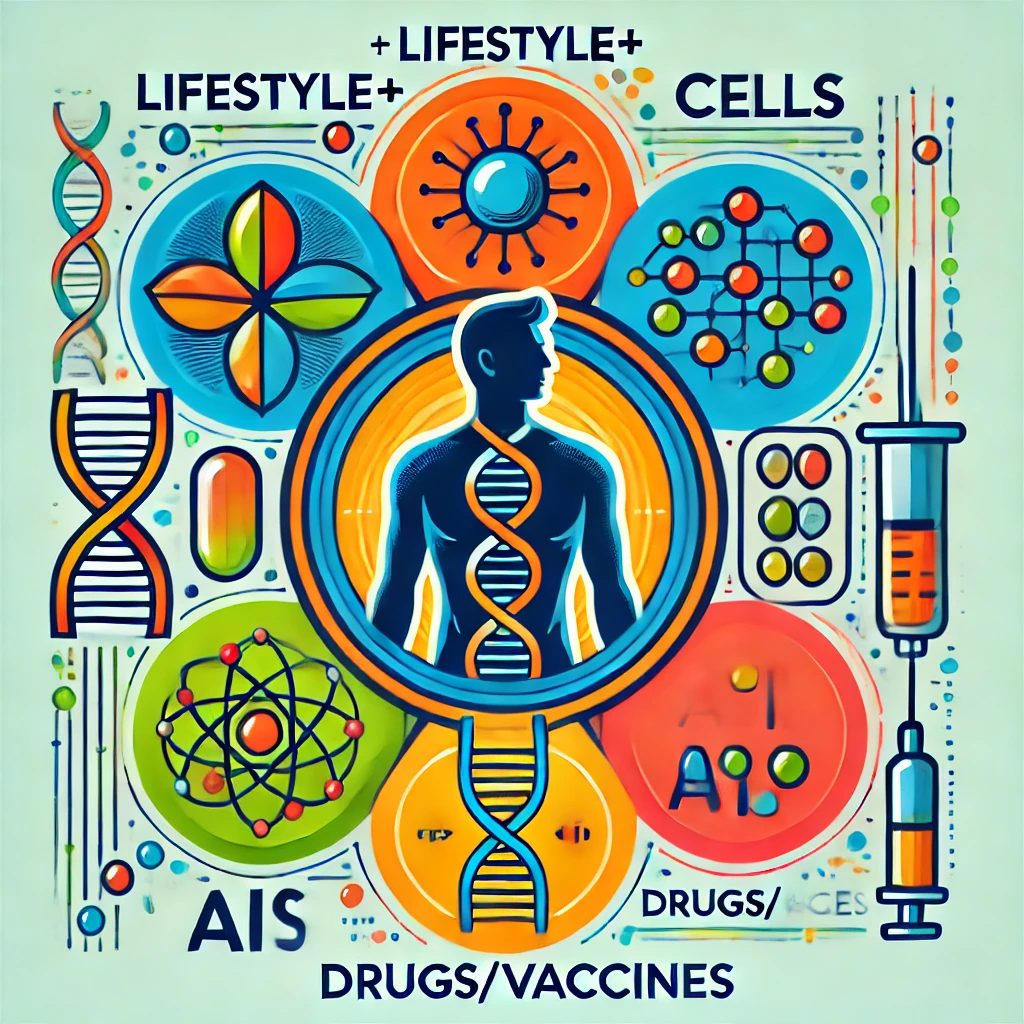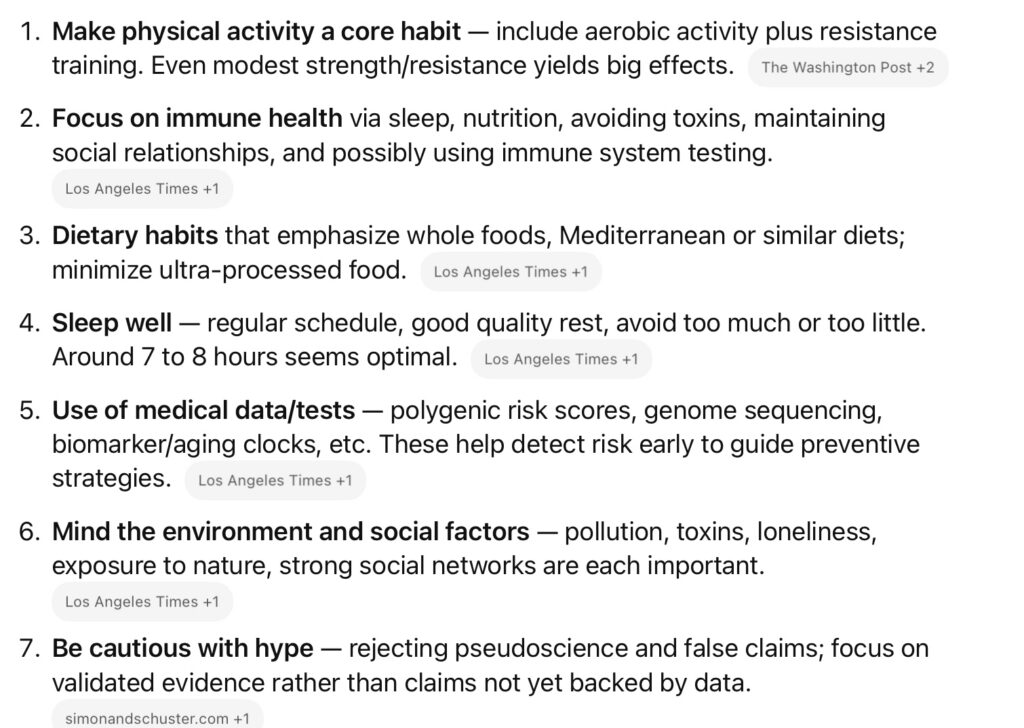
ChatGPT:
Here’s a detailed summary of Super Agers: An Evidence-Based Approach to Longevity (Eric Topol, May 6, 2025) — its main arguments, evidence, key recommendations, and some strengths/limitations. If you want, I can also pull out specific chapters or actionable checklists.
What the Book Is About
Eric Topol’s Super Agers is a deep dive into what current science tells us about aging well — not just living longer, but living healthier (i.e. extending healthspan).
He argues that recent advances in biology, artificial intelligence, genomics, etc., combined with lifestyle changes and better preventive medicine, make it possible to delay or reduce the burden of chronic disease (heart disease, cancer, neurodegeneration, diabetes) far more than has been possible before.
Topol introduces the idea of “super-agers” (or the “wellderly”) — people in their 80s and 90s who show few or no chronic illnesses — and uses them as both inspiration and case studies to see what factors correlate with healthy aging.
Key Themes / Dimensions
Topol organizes his evidence around five major dimensions that interact to affect aging and healthspan.

What the Science Says / Evidence
Some of the strongest findings and evidence Topol emphasizes:
- Genetics ≠ Everything. In studying ~1,400 people aged 80+ who were free of major chronic disease, there was little genetic commonality. Their longevity and health weren’t strongly predicted by shared genetic variants. Lifestyle made a much bigger difference.
- Exercise (especially resistance/strength training) is especially powerful. It doesn’t just help with muscle strength or mobility, it appears to slow how fast the body’s aging clock progresses. Aerobic activity plus resistance work both matter.
- Lifestyle+ factors are foundational. Diet (Mediterranean‐style, whole foods, minimizing ultra‐processed foods), sleep (roughly 7 hours, avoiding patterns that disrupt sleep), social connectedness, environment (air quality, exposure to nature, pollution) are crucial.
- Early detection and prevention pay off. Many diseases incubate decades before symptoms appear; intervening earlier (even before middle age) can shift disease trajectories. Testing (e.g. biomarkers, genome, risk scores) can help guide preventive strategies.
- AI & Omics are bringing real leverage. Better tools for forecasting, diagnostics, personalized treatment, plus data about what works (or doesn’t) for given individuals. But also caution: these tools are powerful, but not magic; there are risks of overclaiming, or using them without enough validation.
- Drugs (e.g. GLP-1s) and vaccines are increasingly important, but not stand-alone. They are best used in concert with lifestyle, prevention, and personalized medicine.
What Topol Recommends / Practical Advice
From what is in the book and interviews:
- Make physical activity a core habit — include aerobic activity plus resistance training. Even modest strength/resistance yields big effects.
- Focus on immune health via sleep, nutrition, avoiding toxins, maintaining social relationships, and possibly using immune system testing.
- Dietary habits that emphasize whole foods, Mediterranean or similar diets; minimize ultra-processed food.
- Sleep well — regular schedule, good quality rest, avoid too much or too little. Around 7 to 8 hours seems optimal.
- Use of medical data/tests — polygenic risk scores, genome sequencing, biomarker/aging clocks, etc. These help detect risk early to guide preventive strategies.
- Mind the environment and social factors — pollution, toxins, loneliness, exposure to nature, strong social networks are each important.
- Be cautious with hype — rejecting pseudoscience and false claims; focus on validated evidence rather than claims not yet backed by data.
Strengths & What Makes It New / Valuable
- It serves as a counterweight to a lot of “anti-aging” hype, biohacking, and unproven claims. Topol emphasizes rigorous studies and what is actually backed by evidence.
- Holistic view: combining biology, lifestyle, new tech. Not just “you must eat well” or “take supplements” but integrating multiple dimensions.
- Timely: many of the tools (AI, omics, new medications, improved diagnostics) are coming into use now, not decades in the future. So the book provides both current practices and future promise.
Limitations, Caveats, & What’s Still Unknown
- Long-term evidence gaps. Some interventions look promising but lack long-term randomized trials in humans showing they change aging trajectories for large populations. Some biomarker clocks need further validation.
- Risk vs benefit & safety. New drugs, therapies have side-effects or unknown long-term impacts. Also, what works for one person may not work for another.
- Access & equity issues. Advanced diagnostics, personalized medicine, gene technologies, etc., may be expensive or unavailable to many. Social determinants of health still generate large disparities.
- Genetic diversity & representation. Much of the genomic data is still skewed toward populations of European ancestry; risk scores and predictions may not generalize globally.
- Complexity for laypeople. Some of the biology is detailed and technical; translating into what individuals should do (especially in resource-limited settings) isn’t always simple.
Take-Home Messages
- Living many years free of major disease (healthspan) is becoming increasingly possible through a combination of lifestyle, prevention, diagnostics, and new medical tools.
- Among lifestyle factors, physical activity (especially strength/resistance training), diet, sleep, social connection are foundational.
- Use of omics and AI helps tailor preventive strategies and detect risk much earlier.
- The future of aging well won’t be about miracle pills, but more about integrating multiple validated means, and doing so earlier rather than later.
